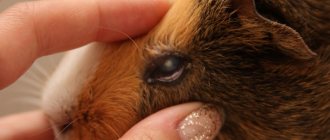/ Hamsters / Causes of bleeding in a hamster
0
2826
Article rating
A dwarf hamster, like any pet, requires proper care, care and attention from its owner. But even under ideal conditions, such a seemingly tenacious pet is not immune from disease. If you see blood flowing from your hamster's nose or under its tail and don't know what to do, then this information will be useful to you.
Causes of bleeding in a hamster
Diseases of Djungarian hamsters: main symptoms and treatment methods
Djungarian hamsters are domestic miniature, decorative rodents. Djungaric hamsters live from 1 to 4 years. Four years of age is considered a rarity among hamsters; such rodents are considered long-lived
. Djungarians do not like long exposure to sunlight
, they are negatively affected by loud sound and brightly fast video clips on television.
Diseases of Djungarian hamsters depend on the conditions of detention. Hamsters require a spacious cage
, since the animals themselves are mobile animals, they also do not tolerate the accumulation of garbage and excrement in their habitat.
proper nutrition has a great influence on hamsters . In this way, you can achieve a healthy life expectancy for the animal.
Long-term research has revealed that their diet must include vegetables and fruits, namely carrots and zucchini.
It is these two food products that contain the very elements that have a positive effect on the digestive system of Djungarian hamsters.
Classification of diseases
According to the type, hamster diseases, like those in humans, are divided into contagious and non-contagious. The following diseases are contagious.
- Bacterial infections. Cause gastrointestinal, skin and other inflammatory processes.
- Viral infections. They affect the eyes and mucous membranes and cause tumors.
- Fungal. Mainly they cause skin diseases.
- Infection with parasites (fleas, ticks, worms).
Some of these diseases can be transmitted to people. You need to be extremely careful when contacting a sick animal and take it to a veterinarian as quickly as possible.
Only a doctor, after performing tests, will make a final diagnosis and give a prognosis for the possibility of recovery. Unfortunately, many diseases are fatal to a hamster.
But in any case, a loving owner will do everything in his power to ensure that the hamster recovers.
Non-communicable diseases include non-communicable diseases.
- Injuries and bruises caused by falling from a height or fighting with other cage occupants.
- Metabolic disease. For example, diabetes mellitus, which most often affects Djungarian hamsters.
- Diseases caused by stressful situations. These include heart disease, heart attacks, and strokes.
Diseases in Syrian hamsters are most often associated with gastrointestinal infections.
Heart problems
In some situations, Djungarian hamsters may experience heart problems, mainly due to stressful situations. Such pathological abnormalities are indicated by symptoms such as shortness of breath, heavy breathing, constant weakness, trembling in the paws and weak pulse.
If a dzhungarik has shortness of breath and heavy breathing, he may have heart problems
If you find at least one symptom indicating heart problems, you should consult a veterinarian in order to make an accurate diagnosis and find out how dangerous the abnormality is developing in the animal’s body.
When to sound the alarm
How to understand that a hamster is sick. If the animal is healthy, it is active, it has smooth shiny fur, clear, clean eyes and a good appetite. But if you notice that your pet is behaving unusually, take immediate action. Your hamster is sick if some of the following symptoms are noticeable:
- eats poorly or refuses food altogether;
- eyes become watery or festering;
- frequent loose stools;
- constipation, dry stool or no stool at all;
- blood dripping from the anus;
- difficulty or hoarse breathing, cough;
- nasal discharge or excessive drooling;
- wet or dull, matted fur;
- ulcers, wounds, peeling skin, bald spots on the skin;
- tumors, bloating;
- lethargy, low mobility;
- the hamster is trembling, although the room is warm.
An animal's underweight may also be a sign of illness. To find out if your pet is sick, weigh your pet periodically. The weight of an adult Syrian is about 90 g, the weight of a Djungarian is at least 30 g.
Winter dream
With the arrival of winter, hamsters begin to realize that the days have become shorter and it is time to sleep. In order for rodents to maintain the required body temperature during this period, they need to constantly eat. The hamster is an intelligent and economical animal. He knows that if he constantly eats up his reserves, he may not live until spring. Therefore, in winter, rodents hide in their house and go to bed until spring.
At home, the hamster sleeps during the day and runs around at night. But do they hibernate?
Hibernation in domestic rodents
The hamster has its own cycle according to which it lives. At home, hibernation does not occur every year. But when hamsters sleep day and night also on their backs, the first thing the owner thinks about is that the pet is probably dead.
There is no need to panic, first you need to check whether the animal has died or has simply become numb for a while. Yes, this happens in rodents of this species. In order to find out what happened to him, it is worth knowing the reasons for the numbness.
Contagious diseases in hamsters
An animal can become infected with a bacterial or viral infection in several ways.
- From other sick animals through direct contact or through its waste products.
- Through contaminated food or water.
- Insect bites.
- Through litter and uncollected excrement.
Respiratory infections are activated by hypothermia, stress and lack of vitamins in the body. You can tell that a hamster is sick by its behavior. He will become lethargic and apathetic.
You may notice discharge from the nose. The young, strong hamster will recover in a few days. In weak individuals with reduced immunity, the disease can develop into pneumonia. The animal will cough and breathe heavily.
In a few days he will die.
Source: https://prokamen.com/gryzuny-uhod/bolezni-homyachkov.html
What to do when you can’t help a dying person
When the hamster cannot be helped, it is advisable to euthanize it. The procedure is practically painless and costs from 500 to 1000 rubles. Euthanasia should be entrusted to a veterinarian and should not attempt to kill the pet yourself. What to do if owners are hesitant to euthanize an animal:
- Provide complete rest to the dying person. The cage should be moved to a quiet room. The hamster should not be touched unnecessarily.
- Do not try to feed your pet if he refuses to eat.
- Offer your hamster water. The animal is unable to approach the drinking bowl without assistance. The rodent's nose can be moistened with water so that it can lick off the droplets.
Hamster bleeding: under the tail, from the nose
Slonvartire.ru / Hamsters / Causes of bleeding in a hamster
0
1828
articles
A dwarf hamster, like any pet, requires proper care, care and attention from its owner. But even under ideal conditions, such a seemingly tenacious pet is not immune from disease. If you see blood flowing from your hamster's nose or under its tail and don't know what to do, then this information will be useful to you.
Causes of bleeding in a hamster
Causes of bleeding under the tail
There are several reasons why pet rodents have bloody discharge under their tail:
- If your pet lives in a cool, drafty room, he is at risk for genitourinary diseases. Due to constant hypothermia, he can become seriously ill, resulting in bleeding in the anus. Such a pet experiences frequent urination, viscosity and cloudiness of urine. Therefore, if you have already acquired such a pet and want it to be healthy, install the cage in a room with a temperature of at least 18 degrees. Of course, your pet hamster needs fresh air, so when you ventilate the room, take the animal to another room to avoid hypothermia.
- Often, blood on the butt can occur in older people. The reason for this is the daily intake of protein throughout life. In addition, old animals can suffer from chronic viral infections. Males aged 2-3 years may develop a cyst. To determine it, the veterinarian carries out special diagnostics. After identifying the formation, a special manipulation is carried out, which helps to prolong the life of the animal, although not for long.
- Pet hamsters often suffer from diseases caused by viruses and bacteria. Chronic viral and bacterial diseases negatively affect the functioning of the kidneys, as a result of which the hamster develops blood on its butt. Moreover, the development of such diseases is possible in animals both at a young and mature age.
- A very popular rodent disease is leptospirosis. Domestic rodents can “catch” such a disease from mice. The main signs of leptospirosis are yellowing or paleness of the skin, which is a consequence of anemia and hepatitis. Presence of bloody threads in the urine. He becomes weak and lethargic. As a result, an inflammatory process begins in the kidneys and bleeding under the tail. Lymphocytic choriomeningitis - this disease is dangerous not only for domestic rodents, but also for humans.
- Kidney disease in a pet can cause diabetes. Preventive measures against this disease consist of replacing the hamster’s usual diet with a dietary one. All products that can be eaten by people, cats and dogs are excluded.
- Eating only dry food can cause the formation of kidney stones. This may cause your hamster to bleed under its tail. A sick rodent constantly tries to hide. He may have increased sleepiness, low activity and lack of appetite. There is also an increased need to drink. The final diagnosis is made after radiography of this area.
What to do
The veterinarian will determine the cause and help your pet
If these signs are present, your pet animal should be urgently shown to a specialist. The sooner you contact a veterinarian, the greater the chance of a speedy recovery. It would be a good idea to collect the rodent’s urine in a sterile container and take it to a veterinary clinic within three hours. After an accurate diagnosis, the doctor will prescribe treatment for your pet.
In addition to treatment, you will be required to carry out a number of hygiene procedures:
- house cleaning every other day;
- general cleaning of the cage using disinfectants (potassium permanganate solution, soda solution);
- daily cleaning of the toilet, since it is in this place that there is a high probability of developing pathogenic microflora.
Often, treatment of the disease that causes blood to appear under the tail of a domestic furbaby is successful. But provided that you promptly seek help from a veterinarian.
Nosebleeds
If your hamster is bleeding from the nose, it is likely that the animal has been injured. Nosebleeds can be the result of a fight between rodents. This phenomenon can be observed quite often if animals live in pairs or in groups.
Provide each pet with separate housing. These animals love to live on their own.
If your pet was injured during a fight, it needs to be taken to the vet immediately. The doctor will prescribe competent treatment that will eliminate bleeding and promote wound healing.
Other causes of nosebleeds:
- Benign and malignant brain tumors.
- Increased intracranial pressure.
- Presence of chronic infections.
It is not always possible to identify such diseases in time. At an early stage, you can still try to save the animal. A neglected case ends in death.
Therefore, if you notice that your furry dog’s nose is bleeding, do not delay - immediately take him to the veterinary clinic for examination.
The hamster is bleeding. What to do if your hamster is bleeding?
Source: https://SlonVKvartire.ru/homyaki/krov.html
What is the danger
Repeated nosebleeds may indicate a defect in the vascular wall. Regular blood loss will lead to anemia and decreased immunity. The situation will be corrected by cauterizing the vessel using liquid nitrogen, radio waves or a laser.
In rare cases, nosebleeds lead to serious blood loss and anemia. The patient begins to experience shortness of breath, heart rate increases, blood pressure drops, and fainting occurs. Bleeding that is localized deeply is dangerous; blood flows down the back wall of the larynx; the victim may choke or choke.
Blood from the nose is a symptom of serious diseases: hypertension, coronary heart disease, atherosclerosis, hypothyroidism, pathology of the adrenal glands, kidneys and liver, tuberculosis. Then it is necessary to undergo examination by specialized specialists.
Sometimes nosebleeds occur due to internal bleeding. If it is bright scarlet and foams a little, there is a lesion in the lungs, and if it is brownish, coffee-colored, it is in the stomach.
Why does a hamster bleed?
The appearance of traces of blood in the genital area and anus in a hamster is a phenomenon that owners of pet rodents often encounter.
This is an alarming sign that requires immediate intervention, although there is no need to panic prematurely.
Most often, such symptoms indicate an illness, but if you do not delay treatment, nothing irreparable will most likely happen. Before starting treatment, it is necessary to determine the possible causes of bleeding.
Why does my pet pee in blood?
Traces of blood in the urine of a Djungarian, Syrian, or any other species of hamster can occur as a result of diseases of the urinary tract. But the diseases themselves and the causes of their occurrence are very different.
How can a hamster get sick?
With a high degree of probability, bleeding can occur for the following reasons:
- the cage is installed in a draft or in a cold place;
- the animal’s diet is oversaturated with proteins;
- chronic viral diseases (more common in fairly mature rodents);
- viruses, bacteria (including rickettsia);
- leptospirosis (with a high degree of probability can develop if the hamster lives next to decorative mice);
- lymphocytic choriomeningitis (a form of the disease that is dangerous for people - a rather rare phenomenon);
- diabetes;
- stones in the bladder and urinary tract.
Important! You should not often feed your hamster sweet fruits - they can cause diabetes. One of the signs of this disease is thick, cloudy urine mixed with blood.
The most common causes of bleeding and illness are listed. However, only a veterinarian can establish a true diagnosis; it may be necessary to take certain tests from the animal.
How to identify diseases of the genitourinary system
Not only obvious signs (blood in the urine) will tell you about the likely development of the hamster's disease. The following symptoms may indicate that something is wrong with the animal’s urinary system
- urine has become viscous and cloudy;
- the rodent experiences pain during urination, as evidenced by its squeaking;
- the pet’s general condition has become apathetic, he himself looks weakened;
- loss or noticeable decrease in appetite;
- the animal is constantly thirsty;
- the hamster pees often.
Did you know? A hamster can hide up to 90 kg of food in reserve. In addition, the rodent can carry a mass of grain equivalent to 20% of its body weight in its cheek pouches.
If your pet has at least some of these symptoms, you need to consult a specialist; do not wait until everything returns to normal over time. In this situation, the sooner the cause of the disease is established and treatment is started, the greater the chances of a favorable outcome.
What do we have to do
If you notice that your rodent has begun to urinate blood, try using a syringe to collect the urine and take it to the vet within three hours. After carrying out certain tests, and possibly examining the animal, the specialist will make a diagnosis and prescribe treatment.
You, regardless of the diagnosis and prescribed procedures and medications, need to immediately thoroughly clean the cage. All surfaces must be treated with a disinfectant. Suitable solutions include 3% chloramine solution, chlorhexidine, potassium permanganate solution, etc.
Disinfection procedures must be carried out without fail, otherwise fungi, the causative agents of aspergillosis, a dangerous disease that affects most of the internal organs of the animal, may begin to develop in the places where the rodent urinates.
Reasons why a hamster bleeds from the anus
A situation is possible in which it is not possible to accurately determine the source of bleeding in a furry animal. The anus and genitals of the animal are located nearby, and given the miniature size of the hamster, it is quite difficult to localize the bleeding area.
https://www.youtube.com/watch?v=n6RXGcBDkNc
In this case, first of all, you should take a cotton pad soaked in a 3% solution of hydrogen peroxide and gently wipe it under the tail and the area around the butt. Once the blood has been removed, you may be able to more accurately determine the source of the bleeding.
The reasons for this phenomenon, as with urination with blood, can be different:
- Poor nutrition. Traces of blood from the anus can be caused by intestinal bleeding due to eating foods that irritate the mucous membrane or cause mechanical damage to the gastrointestinal tract (onions, garlic, almonds, citruses).
- Viral and bacterial infections, tumors (including malignant ones), mechanical injuries due to a fall from a height.
- Damage and injuries resulting from playing or fighting with other rodents (when kept in groups).
- A female may bleed as a result of sexual intercourse with a very large male. In a pregnant woman, such symptoms are a likely sign of a miscarriage caused by stress or trauma.
In any case, the animal must be taken to the veterinarian; only a specialist can establish an accurate diagnosis and prescribe effective treatment.
What to do if your hamster has nosebleeds
Source: https://atlantstroy116.ru/pochemu-krovotechenie-u-homjaka/
First aid
- Calm the victim. The more worried a person is, the more actively the heart beats and the more bleeding.
- The best position is to sit and lean forward slightly. You can’t lie on your back or throw your head back too much, although many people do just that reflexively. This way you will not stop the bleeding, you will simply swallow the blood. There will be a risk of choking.
- Squeeze the wings of your nose with your fingers for a few seconds, you can place a cotton swab soaked in hydrogen peroxide in the nostril, or use vasoconstrictor drops.
- It is necessary to restore breathing: loosen the clothes around the neck, ventilate the room.
- You need to breathe deeply and evenly: inhale through your nose, exhale through your mouth.
- Wrap the ice in a towel or simply dampen the cloth with cold water. Apply the cold to the bridge of your nose. It is advisable to keep your feet warm at this moment. In the area of the nose, the vessels will narrow, and on the periphery they will expand, and the blood will flow away from the face.
- If you suffer from hypertension, measure your blood pressure. If the readings are high, take a pill that normalizes blood pressure.
- If the bleeding does not stop within 15–20 minutes, you feel dizzy, your ears are ringing, or you have tachycardia, call an ambulance.
The hamster is bleeding from the anus (under the tail) - website about pets
According to the type, hamster diseases, like those in humans, are divided into contagious and non-contagious. The following diseases are contagious.
- Bacterial infections. Cause gastrointestinal, skin and other inflammatory processes.
- Viral infections. They affect the eyes and mucous membranes and cause tumors.
- Fungal. Mainly they cause skin diseases.
- Infection with parasites (fleas, ticks, worms).
Some of these diseases can be transmitted to people. You need to be extremely careful when contacting a sick animal and take it to a veterinarian as quickly as possible.
Only a doctor, after performing tests, will make a final diagnosis and give a prognosis for the possibility of recovery. Unfortunately, many diseases are fatal to a hamster.
But in any case, a loving owner will do everything in his power to ensure that the hamster recovers.
Non-communicable diseases include non-communicable diseases.
- Injuries and bruises caused by falling from a height or fighting with other cage occupants.
- Metabolic disease. For example, diabetes mellitus, which most often affects Djungarian hamsters.
- Diseases caused by stressful situations. These include heart disease, heart attacks, and strokes.
Diseases in Syrian hamsters are most often associated with gastrointestinal infections.
"Wet tail" or colibacillosis
One of the most dangerous diseases. It is highly contagious and has a severe course. If the disease is neglected, the animal can die in just 2-3 days! To avoid illness in your animals, do not make mistakes in caring for your pets. Maintaining hygiene, living conditions and proper feeding will help you prevent a “wet tail”.
If your animal suddenly has a decrease in appetite, and after some time an upset stomach or diarrhea occurs, take a closer look. The hamster may refuse to eat or drink water. This may be caused by colibacillosis. Wet fur on the hamster's abdomen and around the anus is one of the main symptoms of the disease.
At the slightest suspicion of a “wet tail,” take your pet and run to the clinic. Delay can lead to dehydration. And this is a threat to life.
Treatment of the disease is carried out only at an early stage; in the later stages, nothing can be done. Veterinarians prescribe tetracycline supplements to food or water for colibacillosis.
In serious cases, chloramphenicol injections may be needed.
Cystitis
Inflammation of the bladder or cystitis often occurs from hypothermia. Rodents do not have good thermoregulation, so even an ordinary draft can provoke it. The most important rule is to protect your pet from hypothermia:
- hide it from the fan and open windows;
- remember its sensitivity to temperature changes;
- protect from drafts.
Simple rules, but how many difficulties can be avoided by simply closing the window in time! With cystitis, a hamster experiences a burning sensation when urinating and constant pain in the lower abdomen. He won’t be able to talk about it, but it’s possible to find out about the disease. As with colibacillosis, cystitis makes the hamster's fur wet. Losing fluid in such quantities can lead to dehydration.
It is because of the similarity of symptoms that you need to seek a final diagnosis from a specialist. If you suspect inflammation of the bladder, you should immediately go to a veterinary hospital, where they will tell you exactly what happened to your pet. Typically, for cystitis, your veterinarian will prescribe antibiotic treatment. To prevent this, it is better to take care of your pet’s health in advance.
Worm infestation
Furry animals, like any other, are at risk of becoming infected with intestinal parasites. This is an unpleasant disease, but it is curable. Common types of internal parasites are tapeworms and roundworms. Their habitat is the intestines. Simple rules will ensure your pet is protected from worms:
- Maintain the correct feeding regimen.
- Choose only proven food.
- Avoid contact with infected animals.
Most often the disease is asymptomatic. But an attentive owner will definitely notice changes in the behavior and condition of the animal.
Wet, greasy hair, weight loss with increased appetite, and upset bowel movements indicate the presence of parasites. You can treat helminthic infestation at home. It is not necessary to involve a doctor in this.
To get rid of it, a course of deworming medications is enough. Choose medications that are specifically designed for rodents.
Other reasons
Diseases are not the only reasons why an animal’s fur has become damp. This is a consequence of the fact that the pet recently experienced severe stress. Because of it, the body temperature rises. Nervous shock is an indication that you made some mistake in caring for the animal. It happens, no one is perfect.
For example, guests came to you and squeezed him in. Naturally, he will have a nervous breakdown. The next time there are strangers in the same room as the hamster, try to prevent them from playing with the animal.
There are not many reasons for a change in the condition of the coat, but the consequences can be very sad. Be sure to consult with specialists at a veterinary clinic if you suddenly see that your pet is not the same as usual.
You can refuse outside help only if you are sure that the changes occurred due to helminths. In other cases, this is a direct route to the veterinarian.
Metabolic disorders
Metabolism is the proper functioning of all body systems. Food processing, energy production, removal of unnecessary and harmful products. The central nervous system is responsible for all this, but the glands that secrete hormones have a huge influence on metabolic processes. These include the thyroid and pancreas, adrenal glands, pituitary gland, and gonads.
Diabetes mellitus can develop due to excessive consumption of carbohydrates. Hereditary predisposition to the disease also plays a role.
You can find out that a hamster has contracted this disease by the characteristic smell of acetone, which comes from the rodent’s saliva and urine. But only a doctor can make a final diagnosis by doing a blood test.
Source: https://zoovet52.ru/cherepahi/u-homyaka-krov-iz-zadnego-prohoda-pod-hvostom.html
Which doctor should I contact?
If bleeding is frequent, heavy, and difficult to stop, make an appointment with an otolaryngologist. He will assess the condition of the blood vessels. If necessary, he will schedule a consultation with a therapist and cardiologist to rule out VSD, hypertension, and other pathologies. In the medical field I accept otolaryngologists of the highest category. In one place you will be able to see the necessary specialists and take the necessary tests. The clinic also has a pediatric ENT doctor. It is possible to solve the problem of recurring bleeding in one or two doses.
The hamster is bleeding from the anus. the hamster is bleeding from the anus (under the tail)
If a hamster is peeing blood, it most likely has problems with the functioning of the urinary tract. Certain factors contribute to the occurrence of diseases directly related to their work.
Causes
The main reasons for the appearance of bloody discharge in a pet’s urine are:
- placing the cage in a cool place, in a draft;
- abuse of protein foods throughout life;
- the presence of chronic viral infections (usually affects older individuals);
- the presence of diseases of a requetsial, viral, bacterial nature;
- development of leptospirosis (possible when animals are kept together with domestic mice);
- development of lymphocytic choriomeningitis (a disease dangerous to humans, which is extremely rare);
- diabetes;
- the presence of stones in the bladder.
To identify certain points, the hamster will have to undergo a detailed examination, possibly an ultrasound, so that the veterinarian can suggest treatment appropriate to the situation.
Symptoms
In addition to bloody discharge, diseases of the genitourinary system are indicated by symptoms such as:
- viscous, cloudy urine;
- the squeak of an animal made during urination;
- weakness;
- decreased appetite;
- the onset of intense thirst;
- frequent urge to urinate.
If you have at least a few additional symptoms, you should immediately contact your veterinarian. Otherwise, the pet may not be saved.
Are hamsters dangerous for children?
Parents do not always decide to buy a dog or cat for their child, fearing that the animal may harm him. And, as an alternative, they buy Djungarian or Syrian hamsters for their children, believing that miniature rodents do not pose a danger to children.
But before giving their baby a hamster, parents should weigh their decision, since these animals are not always harmless and harmless.
If a child is under five years old, it is not recommended to purchase a hamster as a pet.
After all, despite the fact that these cute creatures are quite friendly, they can bite the baby if he frightens them or accidentally hurts the animal.
Such bites are dangerous because the wound can become inflamed due to an infection that has entered it if the affected area is not treated with an antiseptic in time.
Rodents are also carriers of various parasites, such as helminths, and can infect a child with them.
After contact with a pet, small children do not always wash their hands and put dirty fingers in their mouths, which increases the risk of contracting parasites.
A miniature dwarf or fluffy Syrian hamster will be an ideal pet for school-age children . The child will not only gain a great friend, but will also learn responsibility while caring for this cute creature.
Can cats or dogs get the disease from a hamster?
How dangerous are hamsters for other pets? The presence of infectious diseases in rodents is not a cause for concern for owners of cats, dogs and other animals. In most cases, the disease is not transmitted to other animals. The exception is mixing the blood of a healthy and sick animal. The situation is possible if there are wounds.
It should be remembered that cats and dogs are also carriers of various diseases. It is necessary to take care of the health of all pets.
Why does a hamster pee in blood?
The reasons for the appearance of blood in the urine of a rodent are:
- Insufficient care. If your pet is frequently hypothermic in a draft or in a cold room, inflammatory diseases of the genitourinary system develop;
- Incorrect feeding. Excessive consumption of protein foods in rodents has a detrimental effect on kidney function;
- Chronic diseases and cysts of the urinary tract in elderly individuals;
- Infectious, viral and rickettsial diseases of the genitourinary system;
- Urolithiasis as a result of monotonous feeding of dry food;
- Leptospirosis and choriomeningitis;
Cystitis in a hamster
Cystitis in a hamster is a disease that affects the genitourinary system
- Causes – The causes of cystitis can be both mechanical damage and nutritional disorders. It is also possible that the disease may appear due to the lack of the proper amount of water in the diet;
- symptoms – frequent urination and increased anxiety;
- treatment is carried out by using drugs such as buscopan. If after a course of taking medications the condition does not improve, it is necessary to re-diagnose using x-rays.
Obesity in hamsters
Obesity in a hamster - an increase in the amount of subcutaneous fat in a hamster can have a bad effect on other organs, such as the heart. By nature, the hamster is a mobile animal and needs constant exercise.
- reasons - a decrease in physical activity, often due to the fault of the owner when living conditions do not meet the requirements;
- symptoms – a visual increase in the fat layer in the hamster. Decreased overall activity
- treatment - increasing the load, installing various treadmills and attractions in the cage. Monitoring caloric intake.
Colibacillosis. Hamster diseases
Colibacillosis in a hamster is a disease of the gastrointestinal tract, which manifests itself in its disorder. Also, this disease is called “ wet tail ”.
It has a bacterial origin. This intestinal pathology can confuse owners
, since in the early stages it is similar to other diseases that are not of a bacterial nature.
- reasons - the presence of unfavorable bacteria in the body, which come from food or water;
- symptoms - the main sign is the presence of diarrhea in a hamster. Subsequently, lack of appetite, water diarrhea, aggressive conditions, bleeding are connected;
- treatment – colibacillosis can be cured only by following all the instructions and recommendations of a veterinarian. Most often, solutions containing electrolytes are used to improve the hydration process. Along with this, antibiotics are prescribed that stabilize the condition of the intestines. It is also necessary to adhere to a certain diet, which involves excluding certain foods from the diet.
Important! Colibacillosis can be transmitted to other individuals. Therefore, if you have other hamsters, they must be isolated from the infected pet.
E. coli is also a disease of hamsters
E. coli in hamsters is a disease that causes significant discomfort to the pet, even death. It is infectious in nature. As the disease progresses, the intestinal flora of the infected hamster changes due to the activity of the microbe.
- reasons – penetration of an animal microbe into the body;
- symptoms – signs of E. coli are a high body temperature in the animal and the presence of bloody diarrhea during bowel movements;
- treatment - the disease in most cases ends in death for the pet. It is very important to fix it in the early stages (which is very difficult, since it develops very quickly), in order to leave at least some chance of recovery.
Enteritis in a hamster
Enteritis in hamsters affects the organs responsible for normal digestion of the animal.
- reasons - doctors call the main factor in the development of enteritis, the lack of hay in the diet;
- symptoms – bloating and diarrhea;
- treatment looks specific. The feces of a healthy animal are taken, mixed in water and administered as an enema to the patient. It is also recommended to include hay in the diet to improve digestion.
Poisoning - diseases of hamsters
- reasons: poor quality of food consumed, presence of household chemicals on food products. Dirty or stagnant water;
- symptoms – loss of appetite, lethargy.
Sometimes diarrhea and vomiting; - treatment – a veterinarian should prescribe treatment based on the results of the examinations.
It is important to distinguish poisoning from a viral infection. Failure to seek help in a timely manner can result in death.
Lymphocytic choriomeningitis in hamsters
Lymphocytic choriomeningitis in hamsters is a very serious disease that is infectious in nature. Affects all organs.
- reasons - an animal can become infected through contact with a sick individual. The main carriers of this disease are mice;
- symptoms - appear almost immediately and are expressed in general weakness, difficulty breathing, body temperature increases;
- Treatment – this disease, unfortunately, is incurable. If your pet has become a victim of lymphocytic choriomeningitis, measures should be taken to euthanize the hamster. This is the only way to put him out of his misery.
Important! All hygiene rules must be followed; this disease can be transmitted to humans.
Aujeszky's disease - what is important to know about this disease of hamsters
Aujeszky's disease - this disease is often called “false rabies”, since they have similar symptoms.
- reasons - the causative agent of this disease is a virus that affects the entire nervous system of the hamster;
- symptoms - signs of the disease do not appear immediately, but only after two to three weeks after infection. The disease manifests itself in increased excitability of the animal and the presence of itching;
- treatment - it is possible to cure Aujeszky's disease only in the early stages; if the disease is advanced, the virus covers the hamster's ligaments, provokes the development of laryngeal paralysis, as a result of which the animal dies.
Source: https://pro-acne.ru/otravleniya/krov-u-homyaka-chto-delat-esli-ona-v-moche-vydelyaetsya-iz-zadnego-prohoda.html
How to properly bury a pet
Some cities have pet cemeteries. You can go to a veterinary clinic and use cremation services. Often owners, not knowing how to bury a hamster correctly, bury it in the park. However, dogs can dig up pets in common areas. Such funerals are prohibited by law.
You should not bury hamsters in a summer cottage if the owners grow fruits and vegetables there. When the cause of death is infection, the decaying corpse will poison the soil. The hamster must be buried away from housing, for example, in the forest. Before handling a dead rodent, you should wear gloves. The dead hamster could carry bacteria that are dangerous to human health.
Main causes of death
If the rodent does not receive proper attention from you, if the rules of care and maintenance are violated, the life expectancy of Djungarian and Syrian hamsters is significantly reduced. In some cases, the death of the animal may occur at the age of 5–6 months.
Do not forget that hamsters are very delicate, fragile and delicate creatures, and every year it becomes more difficult for them to withstand the effects of adverse factors. Considering that many parents buy hamsters as pets for their children, the death of a little friend can cause severe distress or even psychological trauma in a child. Therefore, you need to know why hamsters die, the main causes and signs of their death.
- unbalanced, unhealthy diet;
- feeding with low-quality feed;
- non-compliance with care standards, violation of maintenance rules;
- frequent stress;
- viral-bacterial diseases, fungal infections;
- unfavorable microclimate conditions in the room where the pet is kept (temperature, humidity level);
- autoimmune diseases;
- heart pathologies;
- age-related changes in the body;
- congenital, chronic pathologies;
- old age.
Female hamsters often die during pregnancy and childbirth due to the fact that during this period the body of small pets becomes most vulnerable to adverse factors. In addition, too early pregnancy at 3-4 months can ruin your pet.
Prolonged overheating, hypothermia, sudden changes in temperature conditions, and high humidity pose a great danger to the lives of Djungarians and Syrians. The health of rodents is negatively affected by drafts, dampness, and cold. Do not forget that hamsters are heat-loving animals, and low temperatures can cause coma and death. This is especially dangerous for small hamsters.
In the room where the pet's cage is located, the temperature should be between 22–25 degrees Celsius. Prolonged hypothermia leads to a slowdown, disruption of metabolic processes, and contributes to the development of colds, which pose a mortal danger to small animals.
You need to understand that the lifespan of pet rodents directly depends on the quality of care.
Wrong diet
Hamsters are quite voracious omnivorous creatures. They happily eat everything that the owner offers. At the same time, we should not forget that Djungarians often have digestive problems. The intestines of these pets occupy almost 70% of the total weight. Therefore, foods from our table (sausages, smoked meats, salty, spicy foods, fatty varieties of hard cheeses) should absolutely not be given to hamsters.











